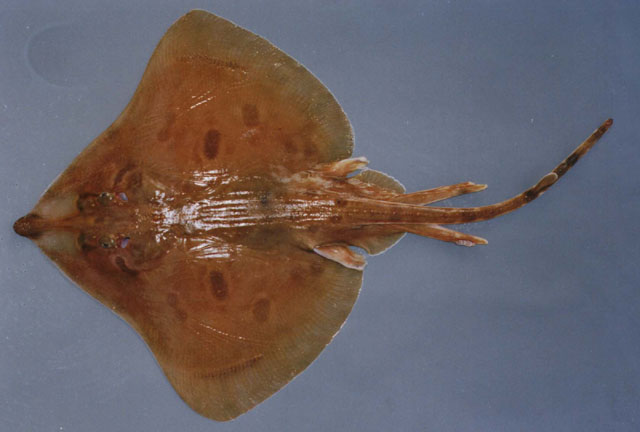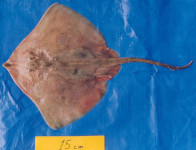Rioraja agassizii
(Müller & Henle, 1841)
Rio skate
Classification: Elasmobranchii Rajiformes Arhynchobatidae
Reference of the original description
Systematische Beschreibung der Plagiostomen. Berlin, Veit, pp. 1–200
Systematische Beschreibung der Plagiostomen. Berlin, Veit, pp. 1–200
Image of the original description
.jpg)
Rioraja agassizi (Müller & Henle, 1841)
.jpg)
Rioraja agassizi (Müller & Henle, 1841)
Synonyms / new combinations and misspellings
Raja agassizi, Raja agassizii, Raja (Rioraja) agassizi, Raja (Uraptera) agassizi, Rioraja agassizi, Uraptera agassizii
Raja agassizi, Raja agassizii, Raja (Rioraja) agassizi, Raja (Uraptera) agassizi, Rioraja agassizi, Uraptera agassizii
Description :
Citation: Rioraja agassizii (Müller & Henle, 1841): In: Database of modern sharks, rays and chimaeras, www.shark-references.com, World Wide Web electronic publication, Version 12/2025
Please send your images of "Rioraja agassizii" to info@shark-references.com

Rioraja agassizii (Müller & Henle, 1841), Size (cm): 33.8 WD, male, Brazil, Macaé, Rio de Janeiro © Marcelo Vianna, Laboratório de Biologia e Tecnologia Pesqueira, Universidade Federal do Rio de Janeiro

Rioraja agassizii (Müller & Henle, 1841), Size (cm): 33.8 WD, male, Brazil, Macaé, Rio de Janeiro © Marcelo Vianna, Laboratório de Biologia e Tecnologia Pesqueira, Universidade Federal do Rio de Janeiro
Common names
 Raya lisa,
Raya lisa,  Ray,
Ray,  Rio skate,
Rio skate,  Arraia-santa,
Arraia-santa,  Raia-santa,
Raia-santa,  Skate
Skate
 Raya lisa,
Raya lisa,  Ray,
Ray,  Rio skate,
Rio skate,  Arraia-santa,
Arraia-santa,  Raia-santa,
Raia-santa,  Skate
Skate
Short Description
Diet: southeastern Brazil (data base: 258 specimens, TL between 96 and 532 mm, sex: 57.85% females, 42.15% male): Nine prey categories were identified: Polychaeta, Copepoda, Cumacea, Isopoda, Gammaridea, Dendrobranchiata, Brachyura, Teleostei, and one non-animal category (nonidentifiable items). Crustaceans were the most important item, indicating that the species has a carcinophagic preference. The presence of fish was just verified in juveniles and some adult individuals, with predominance in summer. Sex, maturity stage and seasonality did not influence the feeding habits of the species. [14289]
Diet: southeastern Brazil (data base: 258 specimens, TL between 96 and 532 mm, sex: 57.85% females, 42.15% male): Nine prey categories were identified: Polychaeta, Copepoda, Cumacea, Isopoda, Gammaridea, Dendrobranchiata, Brachyura, Teleostei, and one non-animal category (nonidentifiable items). Crustaceans were the most important item, indicating that the species has a carcinophagic preference. The presence of fish was just verified in juveniles and some adult individuals, with predominance in summer. Sex, maturity stage and seasonality did not influence the feeding habits of the species. [14289]
Biology
Oviparous, paired eggs are laid. Embryos feed solely on yolk [733]. A coastal species found on sand, mud or gravel bottoms. Feeds on crustaceans, mollusks and fishes.
Oviparous, paired eggs are laid. Embryos feed solely on yolk [733]. A coastal species found on sand, mud or gravel bottoms. Feeds on crustaceans, mollusks and fishes.
Remarks
shark-references Species-ID=7852;
shark-references Species-ID=7852;
Parasites (arranged by Jürgen Pollerspöck)
Myxosporea
Monogenea
Cestoda
Nematoda
Copepoda
Myxosporea
Monogenea
Cestoda
Nematoda
- Pseudanisakis sulameri Santos, Lent & Gibson, 2004 [7387]
- Pseudanisakis sulamericana Santos, Lent & Gibson, 2004 [21220] [31368]
Copepoda
- Brianella corniger Wilson, 1915 [24671]

















